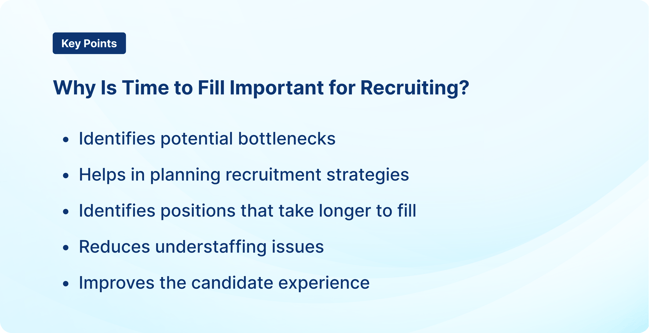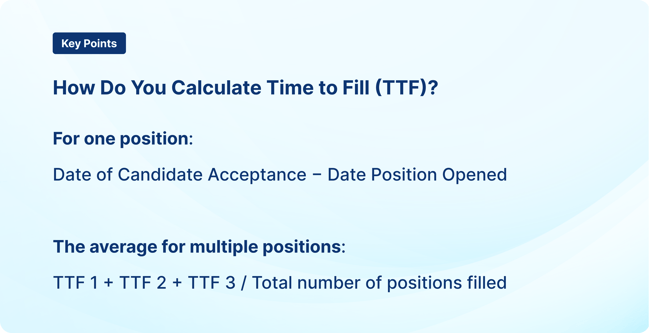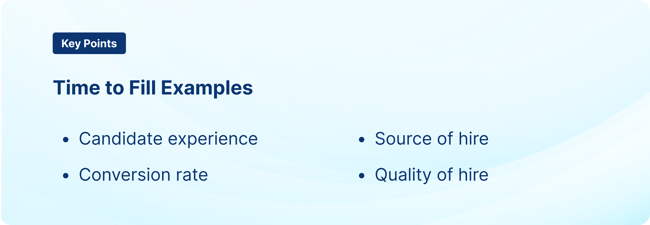

Time to hire is a core metric in the recruitment process. It measures the timeline from when a...

In today's competitive job market, understanding time to fill is paramount for organizations aiming to secure top talent efficiently.
Prolonged vacancies due to a poor hiring strategy can lead to staffing issues and increased employee burnout, hampering organizational productivity.
By understanding and using the right time-to-fill metrics and technology, you can eliminate staffing challenges and maintain efficiency.
Below, we’ll explore the significance of “time to fill” as a valuable key performance indicator (KPI) for your recruiting operations. We’ll also provide actionable strategies to enhance its management for organizational success.
Key Takeaways
|
Time to fill is the duration it takes for you to complete the recruitment process and fill an empty position. It includes the period from the initial job posting to when the candidate accepts of the job.
Time to fill tracks how long it takes you to complete the recruitment cycle from job opening to candidate acceptance. It involves monitoring each stage of the hiring process, including:
To produce a time-to-fill metric, you gather data at every step to analyze the efficiency of your recruitment strategy. By identifying bottlenecks and areas of delay, you can pinpoint where you need to improve.
By analyzing time-to-fill data, you can identify obstacles that prevent your process from being more efficient and effective.
Analyzing time to fill helps you understand more than just the efficiency of your own hiring practices. It can give you insight into market competitiveness and hiring trends, including candidate availability.
With this information at your fingertips, you can refine your recruitment approach and allocate resources where they need to go.
Measuring time to fill requires a structured, methodical approach to recruitment management. It involves defining key stages in the hiring process, such as
You collect data on the time it takes to complete each stage, which helps you assess your recruitment pipeline. It allows you to identify areas for improvement and implement changes to meet talent acquisition goals.

Up-to-date time-to-fill metrics offer you actionable data that allows you to pinpoint specific areas for improvement in your recruitment practices.
For instance, if your time to fill consistently exceeds the industry average, it may prompt a review of the job description. Tracking time to fill can also help in additional ways:
Let's look at each of these in turn.
One common bottleneck involves sourcing strategies, where organizations fail to leverage the right platforms or channels to advertise job openings.
Relying solely on traditional job boards may limit exposure to qualified candidates, especially in industries where passive job seekers are plentiful.
Another bottleneck could stem from delays in the screening and interviewing processes. This occurs due to a lack of standardized procedures or lack of communication.
There may also be an overwhelming volume of applications to sift through. If you manually review each application without utilizing applicant tracking systems, it extends the time it takes to identify suitable candidates.
By understanding the average duration it takes to complete the process, you can anticipate staffing needs and allocate resources accordingly.
If the time to fill for certain roles is longer than others, you can initiate recruitment campaigns to mitigate delays.
Time to fill fosters efficient planning for onboarding and handover procedures once a candidate is selected.
You simplify the onboarding process, ensuring that necessary training and orientation materials are prepared in advance.
Time to fill helps you identify positions that are harder to fill within your organization's recruitment landscape. You can pinpoint specific positions that consistently require a lengthier hiring process.
Your HR team can delve deeper into underlying reasons for delays, such as specialized skill requirements or niche job markets.
As a recruiter, you can also discern which channels yield the quickest and most successful hires for particular positions.
Understaffing impacts productivity and increases the risk of employee burnout and dissatisfaction.
It also impedes collaboration and hinders the achievement of business goals, which affects employee morale and performance.
When you effectively track time to fill, you can manage your recruitment timelines and reduce understaffing issues. It minimizes the likelihood of long vacancies and keeps productivity high without gaps in key roles.
A straightforward, well-organized time-to-fill process ensures that candidates receive prompt feedback and updates throughout the hiring process.
It promotes transparency and engagement. Candidates appreciate timely communication and a high level of professionalism from start to finish.
A shorter time to fill reduces the risk of candidates losing interest due to prolonged waiting after submitting an application.
Prompt communication and efficient decision-making demonstrate respect for candidates' time and effort.

Calculating time to fill involves a straightforward process that enables organizations to assess the efficiency of their recruitment efforts.
The formula for calculating time to fill can be expressed as follows:
Time to Fill = Date of Candidate Acceptance − Date Position Opened
Once you calculate the time to fill for multiple positions, you determine the average time to fill for your organization. The formula may look like this:
Time to fill = TTF 1 + TTF 2 + TTF 3 / Total number of positions filled in that time period
In short, to find the average time to fill, add up the time to fill values for all positions and divide by the total number of positions. This helps you understand the typical duration it takes for your organization to fill vacant positions across various roles and departments.

Time-to-fill metrics offer valuable insights into various aspects of the recruitment process, helping organizations enhance their hiring strategies and improve overall efficiency. Let's explore how different time-to-fill formulas apply to critical recruitment metrics:
Formula: Time to Fill = Date of Candidate Acceptance – Date Position Opened
Example: You calculate the number of days it takes for candidates to receive a job offer after the final interview. A shorter time to fill indicates a positive candidate experience.
Formula: Time to Fill = Date of Final Interview – Date Position Closed
Example: The conversion rate measures the efficiency of converting applicants into hires. Calculating the number of days it takes from the final interview to job offer acceptance helps you assess the effectiveness of your selection process.
Formula: Time to Fill = Date of Offer Acceptance – Date Position Opened
Example: Track the time it takes for candidates sourced from different channels (e.g., job boards, employee referrals, social media) to accept job offers. Analyzing time to fill by source of hire helps identify the most effective recruitment channels for attracting top talent.
Formula: Time to Fill = Date of Hiring Manager Decision – Date Position Opened
Example: Time to fill in relation to your decision reflects the time it takes for hiring managers to evaluate and select candidates. A longer time to fill may indicate a thorough candidate assessment.
Time to fill is a crucial metric that, when tracked regularly, can help guide your organization toward a more efficient hiring process. By diving in deeper, your recruiters can identify bottlenecks, streamline your procedures and elevate the candidate experience.
Cisive can look at your existing process and find ways to help you reduce your time to fill. Speak with an expert for a free assessment of your recruitment process.

Time to hire is a core metric in the recruitment process. It measures the timeline from when a...

For your organization to succeed, you need talented employees who can handle a wide range of...

One of the biggest challenges for hiring managers in developing a hiring strategy is not actually...